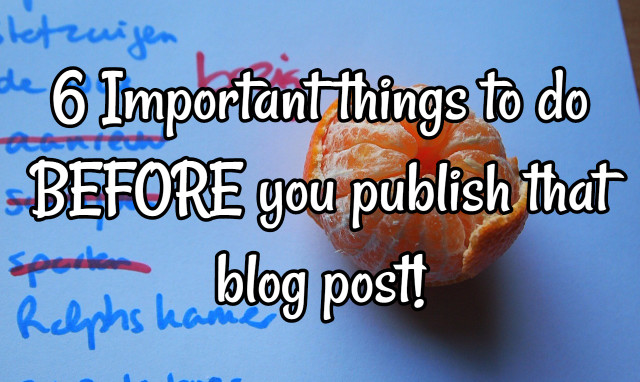



So you’ve worked really hard and have completely written a blog post.
Wohoo! You certainly deserve a pat on your back.
Now, let’s go ahead and publish it, shall we? Nope!
Hold on for a second before you rush to click on that Publish button.
I know it is too hard to hold on when you have a complete blog post ready to be published. Why not publish it right away?
Well, you can certainly publish the post on your blog but only after you do these things.
Here’s a crispy list of 6 important things you need to do before publishing that super-cool blog post of yours.
#1 Write a great intro
Well well, when you say you have a full blog post written doesn’t that include your intro? Not in most cases!
Not everyone writes linearly. And if you’ve been writing for a while you know that intro is not the first thing to write – be it a blog post, or a book or even a sales page.
Intro is something you work on after you have completed the rest of the post.
If you first start with the intro, most probably it won’t be the perfect intro for that particular post after you’ve finished writing it.
It is because, blog posts – or whatever content you write – might change course while you write.
It is pretty usual that you start off writing a piece of content in a particular direction and by the time you complete writing that piece of content, it would have changed course.
It could be a pretty light change or it could be a pretty big change.
But I am sure there will be a change most of the time.
So it would be more appropriate to write the intro in the end.
Usually it goes like this (at least for me) – you get an amazing blog post idea, you start with a working title, outline the blog post, work on it when you get the time, write an intro, then work on the heading and then do the final polishing stuff!
So I always do the headline and intro in the end when I clearly know how the post has come up.
Here’s an ultimate guide on writing blog post intros by Neil. I also love the tips shared by Mary on this topic!
#2 Fill out SEO data
This is not a big thing to do but a very simple thing that can create a bigger impact.
SEO is not dead and I am sure you know that by now 🙂 Plus SEO is not as complicated as it used to be.
So why miss this crucial step?
What do I mean by SEO data? Again don’t be startled when you hear this.
Make sure you have Yoast SEO plugin installed on your blog (here’s help on that).
Once you have this plugin, make sure you enter the Meta title, description for the post.
As you can see above, if you don’t fill anything in those boxes, by default the first few lines of the post are taken as meta description and the page title is taken as SEO title.
So you will have to enter appropriate SEO title and meta description into those boxes, and as well as change the post slug to something more SEO and people friendly.
You will need to use an SEO tool like Semrush to identify related keywords and use them in the meta title and description!
Also make sure that you have a different page title and SEO title for each blog post. This increases your chance using your keyword(s) more on the titles.
Plus it gives you an edge over other bloggers who use the same title for page and SEO – you provide an SEO optimised title for search results, thus increasing your chance of being found.
Don’t forget to check out the list of SEO plugins you could use for your blog!
#3 Format your post
I wish I could pass this tip by saying I don’t have to give this tip – every blogger knows that formatting is important and they do it, right?
I wish I could say that!
I (still, even in this decade) see a lot of blog posts with ridiculously poor formatting.
Formatting is seriously important – and it plays a very crucial role in presenting your awesome content to the readers.
Even an awesome piece of content can go wasted if you fail to format it properly.
Look, people are extremely busy these days and they won’t care to look again and read carefully all the important points and tips you’ve shared in the post.
And if they are not able to easily find out what they are looking for, they are simply going to leave.
Formatting plays a very crucial role in “keeping” your visitors on site – thus reducing bounce rate and increasing on-site time (talking SEO here).
Formatting is not a geeky thing! All you have to do is any/all of the following:
- Include appropriate sub-headings in the post (h2, h3 and so on)
- Break your blog post into short and sweet paragraphs
- Use bold, italics and underline whenever necessary and appropriate
- Insert non-text elements like images, quotes, or tweets to keep your readers engaged
- Use list elements (like this one)
That’s it. Was it difficult?
Read more blog post formatting tips by Sue here.
#4 Proof read
OK I get it. You have worked so hard on your blog post.
So you want to publish it as soon as you have finished writing it so the world comes to know about it ASAP.
I understand. But there is a very important step before you can do that.
You have to proof read your content.
It doesn’t matter how passionately you’ve written it. The mistakes you’ve made may not be directly visible to your eyes – because you are constantly looking into it.
And again I tell you, you are passionately looking at your creation. So it is highly unlikely that you catch crucial mistakes.
Which is why you need a proof reading session for every blog post you create. Simply typing out the content and hitting publish is a terrible mistake.
You should proof read. In this blog post, Rachel explains why proofreading should be part of your content strategy!
Proof reading will help you with identifying grammatical errors, typos, incoherent sentences, unnecessary fluff and much more.
It is the only way to polish your content so it looks clean and professional to your readers.
Think about how your content (and hence your business) will be pictured if you publish content with silly grammatical errors and typos?
You may find these list of proof reading tools useful.
#5 Find appropriate images
The internet is getting more and more visual every day. As they say, a picture is worth a thousand words.
If used correctly, images not only enhance the perceived value of a blog post, but also keeps your readers engaged.
Images give your readers a break from regular (boring) text.
You could use funny, catchy images that go well with the theme of your content.
You could use screenshots to explain stuff (a perfect example of “a picture is worth a thousand words” – instead of writing pages of text to explain how to do something, you could easily show it to your readers using screenshots).
You could insert image quotes. And what not!
Finding appropriate images for your blog content shouldn’t take you long.
There are various places where you could search for the perfect image. For instance, here’s a list.
For a detailed in-depth view on this topic (the why, what and how + tools), check out this blog post.
#6 Check for call to action
I take call to actions very seriously.
They simply help you to achieve your goal much easily.
I assume each piece of content that you intend to publish has its own goal (if not, you are simply wasting your time and resources in publishing blog posts).
Call to actions are those pieces/entities in your blog post, placed appropriately, so that you can achieve that purpose/goal that you intended to achieve.
A simple example is “Click Here”! Yes as simple as that.
But it is important that you say it explicitly – that you ask your readers, or direct your readers to take the desired action.
“Sign up”, “Download”, “Listen for free”, “Buy Now”, “Leave a comment below”, “Share this post now”, “Read the blog” – are examples of call to actions.
You may think that it is not necessary to say it explicitly and that your readers will automatically take that action.
But that’s a no. You must include a call to action so your readers will clearly know what to do (next).
Here’s an awesome list of call to action examples to check out.
I have a sign up box right below every blog post! That’s call to action.
In my home page, right on top I have a BIG sign up form that you cannot miss. That’s call to action.
Just to give you a few more working examples from this blog.
Hold on before publishing that blog post!
Yes you got that! Next time you have that urge to publish the blog post immediately after you finish writing it, hold on.
There are certain important things (like those discussed in this post) that need to be done before you click on that publish button.
Your post deserves such an attention.
If you simply publish a blog post right after writing it, you are publishing a half cooked piece of content.
And that’s simply doing injustice to your awesome content don’t you think?
So the next time you finish a blog post refer to this checklist and make sure you do all these before hitting that Publish button!
[thrive_text_block color=”dark” headline=””] PS: For help on writing great content for your blog, don’t hesitate to pick up my content creation course.[/thrive_text_block]
Recent Posts
Why Passive Income Isn’t Truly Passive – And What You Need to Know
Let’s be honest. We’ve all seen those dreamy social media posts with screenshots of PayPal…
Enhance Your Note-Taking: Discover Google Keep’s Underrated Tools
Google Keep is often overshadowed by more prominent note-taking applications, but it harbors a suite…
The Secret to Writing Blog Posts That Actually Attract Customers
Let’s be honest: Most blogs don’t work. They get published. They sit there. They collect…
Seven Simple Steps To Keep Your Wellness Business In Good Health
If you love helping people unlock increased health and happiness, launching a wellness business could…
Saying No Without Guilt: How to Set Boundaries Without Feeling Bad
We’ve all been there. A colleague asks for a last-minute favor, a friend wants us…
Embracing Imperfection: How Letting Go of Perfection Unlocks Growth
Imagine standing in front of a blank canvas, brush in hand, ready to paint your…





View Comments
Hi, Jane!
The steps mentioned in this blog post are spot-on. I highly recommend following these steps for publishing a blog post.
I always put my personal blog posts into a stepwise editing procedure. Once the blog post goes through that procedure, not only does it make sense, but the copy also gets better.
Useful post, Jane.
Thank you!
Hey Hassaan,
Indeed, I personally feel that an editing session is absolutely necessary for every piece of content. Saves you the embarrassment with publishing content with silly mistakes.
Yes it also does significantly improve the copy for sure!
Thanks for sharing your thoughts.
Cheers,
Jane.
Hi, Jane!
The steps mentioned in this blog post are spot-on. I highly recommend following these steps for publishing a blog post.
I always put my personal blog posts into a stepwise editing procedure. Once the blog post goes through that procedure, not only does it make sense, but the copy also gets better.
Useful post, Jane.
Thank you!
Hey Hassaan,
Indeed, I personally feel that an editing session is absolutely necessary for every piece of content. Saves you the embarrassment with publishing content with silly mistakes.
Yes it also does significantly improve the copy for sure!
Thanks for sharing your thoughts.
Cheers,
Jane.